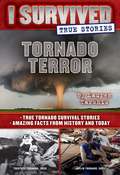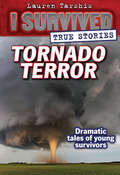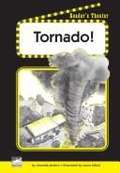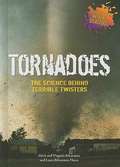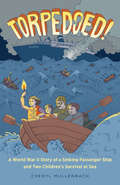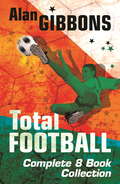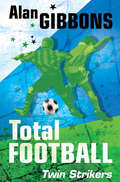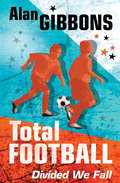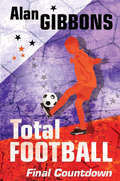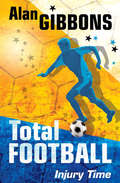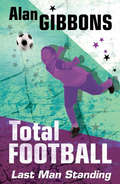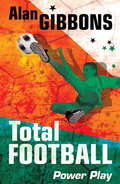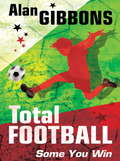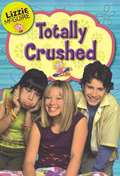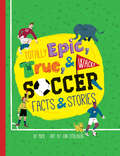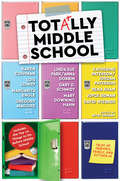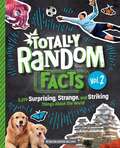- Table View
- List View
Tornado Terror: True Tornado Survival Stories And Amazing Facts From History And Today (I Survived True Stories Series #3)
by Lauren TarshisThe Tri-State Tornado of 1925 was the deadliest tornado strike in American history, tearing through three states and killing 700 people. Almost a century later, the Joplin Tornado was a mile-wide monster that nearly destroyed the heart of a vibrant city. <P><P>The author of the New York Times best-selling I Survived series now brings you the vivid and true stories of two young people who survived these terrifying twisters, along with fascinating facts about tornadoes and profiles of the well-respected scientists and storm chasers who study them.
Tornado Terror: True Tornado Survival Stories and Amazing Facts from History and Today (I Survived True Stories #3)
by Lauren TarshisFrom the author of the New York Times bestselling I Survived series, comes two gripping accounts of two young people who survived two terrifying twisters.The Tri-State Tornado of 1925 was the deadliest tornado strike in American history, tearing through three states and killing 700 people. Almost a century later, the Joplin Tornado was a mile-wide monster that nearly destroyed theheart of a vibrant city. The author of the New York Times best-selling I Survived series now brings you the vivid and true stories of two young people who survived these terrifying twisters, along with fascinating facts abouttornadoes and profiles of the well-respected scientists and storm chasers who study them.
Tornado!
by Jeffrey Fuerst Amanda Jenkins Laura NikielPerform this script about a tornado that is heading towards a home.
Tornadoes: Revised Edition
by Seymour SimonIn this updated and revised edition of Tornadoes, award-winning science writer Seymour Simon gives readers an in-depth look at these captivating and powerful storms through fascinating facts and stunning full-color photographs. This nonfiction picture book is an excellent choice to share during homeschooling, in particular for children ages 6 to 8. It’s a fun way to learn to read and as a supplement for activity books for children.Readers will learn all about tornadoes, from how they are first created to the destruction they leave behind.This updated edition includes:author’s notestunning full-color photographsglossaryindexa list of websites and additional reading sourcesSupports the Common Core Learning Standards, Next Generation Science Standards and the Science, Technology, Engineering, and Math (STEM) standards.
Tornadoes: The Science Behind Terrible Twisters
by Alvin Silverstein Virginia Silverstein Laura Silverstein NunnDiscusses the science behind tornadoes, including how and where they form, the scientific methods to track and predict them, and tornado safety tips.
Torpedoed!: A World War II Story of a Sinking Passenger Ship and Two Children's Survival at Sea
by Cheryl MullenbachWhen 14-year-old Florence Kelly and 11-year-old Russell Park left their hometowns for summer vacations in Europe in 1939, they considered themselves awfully lucky. Many of their friends' families were struggling during the Great Depression and couldn't afford fancy trips. But the young pair would soon face life-threatening troubles of their own as it became clear German dictator Adolf Hitler was intent on invading neighboring countries.With tensions high, Florence, Russell, and their families cut their holidays short as many Americans scrambled to book passage back to the States. Safely aboard the luxurious passenger liner the S.S. Athenia, travelers settled in and breathed a sigh of relief. Surely, it was believed, the sleek, menacing German U-boats lurking in the Atlantic Ocean would never attack a passenger ship . . . would they? Torpedoed! vividly re-creates the events surrounding the attack on the Athenia, the first ship lost in the battle of the Atlantic. Through firsthand accounts, interviews with survivors, and powerful photos, award-winning author Cheryl Mullenbach brings to life the prewar environment in America and Europe, the anxious days leading up to the surprise attack, the frantic rush to escape the sinking ship, and the long, terrifying night that Russell, Florence, and others spent in churning lifeboats battling the elements and imagining the worst. At once a gripping adventure story and a rich resource for history lovers, Torpedoed! provides page-turning thrills and inspiring real-life examples of courage and resourcefulness in the toughest of circumstances.
Total Football Complete eBook Collection (Total Football Ser.)
by Alan GibbonsAn action packed complete collection of the eight book Total Football series from bestselling writer Alan Gibbons. This collection contains the following stories: 1. Some You Win . . . 2. Under Pressure 3. Divided We Fall 4. Injury Time 5. Last Man Standing 6. Power Play 7. Twin Strikers 8. Final Countdown
Total Football Twin Strikers: Book 7 (Total Football Ser.)
by Alan GibbonsThe Rough Diamonds are a close knit team. Kev McGovern, their captain, makes sure they work hard and play hard. The Rough Diamonds are struggling with injuries and loss of form. Talented twin brothers, and new team members, Liam and Conor Savage, should be the answer to all their problems - but could they turn out to be the biggest problem of all?
Total Football: 02 Under Pressure (Total Football Ser.)
by Alan GibbonsThe Rough Diamonds are a close knit team. Kev McGovern, their captain, makes sure they work hard and play hard, but Kev acts swiftly when too many of the lads just aren't playing the game and let pressures off the pitch threaten the team's future.
Total Football: Divided We Fall (Total Football Ser.)
by Alan GibbonsThe Rough Diamonds are a close knit team. Kev McGovern, their captain, makes sure they work hard and play hard. When Kev's best mate, Jamie's world is wrecked by dirty play off the pitch, he's desperate to get everything back to normal.
Total Football: Final Countdown (Total Football Ser.)
by Alan GibbonsThe Rough Diamonds are a close knit team. Kev McGovern, their captain, makes sure they work hard and play hard. Kev has lived total football and worked the Rough Diamonds to the top - but will the ghosts from his past come back to haunt him, ruining all their chances and snatching victory from them?
Total Football: Injury Time
by Alan GibbonsThe Rough Diamonds are a close knit team. Kev McGovern, their captain, makes sure they work hard and play hard. Kev is stunned when he discovers that Dave has to cope with epilepsy. When he suffers a major attack, the victory the Rough Diamonds are so desperate to win, hangs in the balance.
Total Football: Last Man Standing (Total Football Ser.)
by Alan GibbonsThe Rough Diamonds are a close knit team. Kev McGovern, their captain, makes sure they work hard and play hard. Right now, John O'Hara feels he's on the verge of losing everything. His family is about to break up. He's dumbstruck when he finds out that his Mum is seeing his teacher, and Dad...well the less said the better. John feels lonely and insecure; none of this is helping his street cred with the lads, and worse still his form on the pitch is really suffering.
Total Football: Power Play (Total Football Ser.)
by Alan GibbonsThe Rough Diamonds are a close knit team. Kev McGovern makes sure they work hard and play hard.Kev doesn't make any allowances. That goes for the new boy Chris Power who's just signed up with the Diamonds. Can he earn a place in their affections when he's living in achildren's home and trying to make sense of what's happened in his life...?
Total Football: Some You Win Ebook (Total Football Ser.)
by Alan Gibbons'There's me with my mind full of the beautiful game . . . and what are we really, a bunch of deadbeats . . .'But Kev McGovern has a reputation to live up to and when he takes over as captain of the Rough Diamonds he pulls the team up from the bottom of the league, and makes them play to win . . . every match.
Total Knockout: Tale of an Ex-Class President
by Taylor MorrisThere's nothing ordinary about Lucia Latham - she gets straight A's, she's been middle school Class President for two years running and she's a great boxer - nothing is more fun than a good old sparring match with best friend Cooper, especially since she usually wins. In short, there are few things Lucia tackles that don't turn out exactly how she wants them. So at the beginning of her 8th grade year, Lucia has no reason to believe that things won't continue being easy - until she sticks her foot in her mouth in a HUGE way. Then it seems her carefully constructed world is crashing down around her. Can she regain her super star status or will she be forced to lower her expectations?
Total Recall: Remembering Everything (Fountas & Pinnell Classroom, Guided Reading Grade 5)
by Devra SperegenNIMAC-sourced textbook
Total Teen: Tracy Anderson's Guide to Health, Happiness, and Ruling Your World
by Tracy AndersonIgnite your muscles. Clear your mind. Fuel your body. In a world where no selfie gets snapped without a flawless filter and your Instagram idols could teach classes on how to master angles, lighting, and retouching, it’s essential to create a rock-solid relationship with what’s real and what’s beautiful. Here’s the truth: you are real. You are beautiful. You are unique. Fitness pioneer Tracy Anderson is here to be your guide as you fully come to that realization, and fortify yourself with the tools to be your best—physically, mentally, and emotionally. Total Teen gives you a solid foundation to lead a balanced life—with absolutely no calorie counting, no fad diets, and no unrealistic workout routines. It’s a body-positive approach to taking care of and honoring your total self. Learning how to move, connect, and nourish yourself to let your light shine bright. Inside, you’ll find exercises, activities, and recipes as well as prompts and questions to spark new ways of thinking and new ways of being. You’ll be amazed at how good you can look and feel, and how powerfully you can show up for every aspect of your life. Begin now, and you’ll have a head start that will be with you forever.
Totally Crushed! (Lizzie McGuire #2)
by Kiki ThorpeSomeone has a crush on Lizzie -- Larry Tudgeman, the biggest geek in the universe. When he asks her out, Lizzie says no automatically, and she doesn't feel bad about it. Okay, maybe she does feel about it! But if she goes out with him, she'll be branded a nerd for life. Then again, if she doesn't go out with him, she might be missing out on something special... Plus, Lizzie gets assigned to do a school project with her mortal enemy, Kate Sanders. Can the two ex-best friends put aside their differences and complete the assignment?
Totally Epic, True and Wacky Soccer Facts and Stories
by Puck Jon StollbergGet your cleats ready; this is going to be an epic game! Soccer is full of stories about the great players and the amazing GOOOOOOOOOOALS. But soccer also has a wild side, and tons of wacky stuff happens week after week. Some of the stories in this book are weird, a bit odd, and definitely on the crazy side. Others are about amazing (and not so amazing) records and those passionate fans in the stadiums. In all, these are the totally epic, true, and wacky soccer facts and stories that every fan should know. So, start dribbling and be ready for an epic run to the goal!
Totally Joe: The Misfits; Totally Joe; Addie On The Inside; Also Known As Elvis (The Misfits)
by James Howe"Everybody says you and Colin were kissing." "What? That's ridiculous!" "For heaven's sake, Joe, if you and Colin want to kiss, you have every right to." "We did not kiss," I told her. Addie shrugged. "Whatever." What was it with my friends? From the creator of The Misfits, the book that inspired NATIONAL NO NAME-CALLING WEEK, comes the story of Joe Bunch....
Totally Middle School: Tales of Friends, Family, and Fitting In
by Betsy GrobanFrom literary masterminds Lois Lowry, Gary D. Schmidt, Linda Sue Park, Katherine Paterson, Karen Cushman, Gregory Maguire, and more comes a timeless and inspirational anthology about the sometimes-challenging, always-rewarding coming-of-age years: middle school.With eleven short stories told in text messages, emails, formal letters, stories in verse, and even a mini graphic novel, Totally Middle School tackles a range of important subjects, from peer pressure, family issues, and cultural barriers to the unexpected saving grace of music, art, friendship, and reading. Brimming with heart and humor, these poignant stories from bestselling and award-winning authors shine a light on the moments when everything is thrilling and terrifying at the same time--in a way it will never be again.
Totally Random Facts Volume 1: 3,128 Wild, Wacky, and Wondrous Things About the World (Totally Random Facts #1)
by Melina Gerosa BellowsDID YOU KNOW? Dragonflies can see in all directions at once. Cats have a vocabulary of 14 words. And golf balls were originally made from—wait for it—cow&’s eyeballs.Fantastic facts and incredible images come to life in this big, beautiful hardcover book that brings the best of our wonderfully wild world right into kids' hands!The first volume of our beloved TOTALLY RANDOM FACTS series shows kids that the world is a truly amazing place! With literally thousands of wild, weird, and wonderfully random facts about anything and everything, this uber-giftable hardcover pairs amazing photography and cool design with a wealth of intriguing information to leave kids amazed and amused. From the depths of the oceans to the outer reaches of space, if your kid is interested in it, there's a Totally Random Fact about it!
Totally Random Facts Volume 2: 3,219 Surprising, Strange, and Striking Things About the World (Totally Random Facts #2)
by Melina Gerosa BellowsDID YOU KNOW? Male seahorses give birth, not females. Hershey's kisses used to be square. Squid have nine brains--and the central one's shaped like a donut, with a hole in the middle! Even MORE fantastic facts and incredible images come to life in the second volume of the kid-favorite TOTALLY RANDOM FACTS series.There is a wild world of VERY random information out there! This second volume of the beloved Totally Random Facts series rounds up another 3000-plus of those surprising, strange, and striking nuggets of information. Covering everything from cuddly pets to venomous spiders and exoplanets to undersea trenches, this uber-giftable hardcover showcases amazing photography, cool design, and weird-but-true information. If your trivia-phile is interested in it, there's a Totally Random Fact about it!
